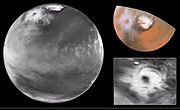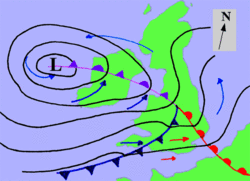
Cyclone
Background Information
This selection is made for schools by a children's charity read more. SOS mothers each look after a a family of sponsored children.

In meteorology, a cyclone is an area of low atmospheric pressure characterized by inward spiraling winds that rotate counter clockwise in the northern hemisphere and clockwise in the southern hemisphere of the Earth. The generic term covers a wide variety of meteorological phenomena. These include tropical cyclones, extratropical cyclones, and tornadoes, so meteorologists rarely use "cyclone" without additional qualification.
Structure
There are a number of structural characteristics common to all cyclones. Their centre is the area of lowest atmospheric pressure, often known in mature tropical and subtropical cyclones as the eye. Near the centre, the pressure gradient force (from the pressure in the centre of the cyclone compared to the pressure outside the cyclone) and the Coriolis force must be in an approximate balance, or the cyclone would collapse on itself as a result of the difference in pressure. The wind flow around a large cyclone is counterclockwise in the northern hemisphere and clockwise in the southern hemisphere as a result of the Coriolis effect (An anticyclone, on the other hand, rotates clockwise in the northern hemisphere, and counterclockwise in the southern hemisphere.)
Formation
Cold-core cyclones (most cyclone varieties) form due to the nearby presence of an upper level trough, which increases divergence aloft over an area that induces upward motion and surface low pressure. Warm-core cyclones (such as tropical cyclones and many mesocyclones) can have their initial start due to a nearby upper trough, but after formation of the initial disturbance, depend upon a storm-relative upper level high to maintain or increase their strength.
Categorization
Each of the six main types of cyclone has further characteristics which define it as either a Polar cyclone, Polar low, Extratropical, Subtropical, Tropical, or Mesoscale.
Polar cyclone
Polar or Arctic cyclones are vast areas of low pressure. A polar cyclone is a low pressure weather system, usually spanning 1,000–2,000 kilometers, in which the air circulates in a counterclockwise direction in the northern hemisphere, and a clockwise direction in the southern.
Polar low

A polar low is a small-scale, short-lived atmospheric low pressure system (depression) that is found over the ocean areas poleward of the main polar front in both the Northern and Southern Hemispheres. The systems usually have a horizontal length scale of less than 1,000 km and exist for no more than a couple of days. They are part of the larger class of mesoscale weather systems. Polar lows can be difficult to detect using conventional weather reports and are a hazard to high-latitude operations, such as shipping and gas and oil platforms.
Polar lows have been referred to by many other terms, such as polar mesoscale vortex, Arctic hurricane, Arctic low, and cold air depression. Today the term is usually reserved for the more vigorous systems that have near-surface winds of at least 17 m/s.
Extratropical
An extratropical cyclone, sometimes inaccurately called a cyclone, is a synoptic scale low pressure weather system that has neither tropical nor polar characteristics, being connected with fronts and horizontal gradients in temperature and dew point otherwise known as "baroclinic zones".
The descriptor "extratropical" refers to the fact that this type of cyclone generally occurs outside of the tropics, in the middle latitudes of the planet. These systems may also be described as "mid-latitude cyclones" due to their area of formation, or "post-tropical cyclones" where extratropical transition has occurred, and are often described as "depressions" or "lows" by weather forecasters and the general public. These are the everyday phenomena which along with anti-cyclones, drive the weather over much of the Earth.
Although extratropical cyclones are almost always classified as baroclinic since they form along zones of temperature and dewpoint gradient, they can sometimes become barotropic late in their life cycle when the temperature distribution around the cyclone becomes fairly uniform with radius.
Subtropical
A subtropical cyclone is a weather system that has some characteristics of a tropical cyclone and some characteristics of an extratropical cyclone. It can form in a wide band of latitude, from the equator to 50°.
Tropical

A tropical cyclone is a storm system fueled by the heat released when moist air rises and the water vapor in it condenses. The term describes the storm's origin in the tropics and its cyclonic nature, which means that its circulation is counterclockwise in the northern hemisphere and clockwise in the southern hemisphere. Tropical cyclones are distinguished from other cyclonic windstorms such as nor'easters, European windstorms, and polar lows by the heat mechanism that fuels them, which makes them "warm core" storm systems.
Depending on their location and strength, there are various terms by which tropical cyclones are known, such as hurricane, typhoon, tropical storm, cyclonic storm and tropical depression.
Tropical cyclones can produce extremely strong winds, tornadoes, torrential rain, high waves, and storm surges. The heavy rains and storm surges can produce extensive flooding. Although their effects on human populations can be devastating, tropical cyclones also can have beneficial effects by relieving drought conditions. They carry heat away from the tropics, an important mechanism of the global atmospheric circulation that maintains equilibrium in the Earth's troposphere.
Mesoscale
A mesocyclone is a cyclonic vortex of air, between approximately 2 and 10 km diameter within a convective storm. They can often be found in association with updrafts in supercells, where tornadoes may form. The term refers only to mesoscale cyclones found within convective storms, and does not apply to other cyclones on the mesoscale. Storms with mesocyclones can feature strong surface winds and severe hail.
Extraterrestrial cyclones

Cyclones are not unique to Earth. Cyclonic storms are common on Jovian planets, like the Small Dark Spot on Neptune. Mars has also exhibited cyclonic storms. Jovian storms like the Great Red Spot are usually mistakenly named as giant hurricanes or cyclonic storms. However, this is inaccurate, as the Great Red Spot is, in fact, the inverse phenomenon, an anticyclone.

